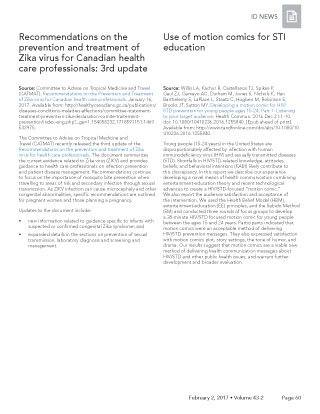ID News: February 2017

 Download this article as a PDF (60 KB - 1 page)
Download this article as a PDF (60 KB - 1 page) Published by: The Public Health Agency of Canada
Issue: Volume 43-2: Sexually transmitted infections
Date published: February 2, 2017
ISSN: 1481-8531
Submit a manuscript
About CCDR
Browse
Volume 43-2, February 2, 2017: Sexually transmitted infections
ID News
Recommendations on the prevention and treatment of Zika virus for Canadian health care professionals: 3rd Update
Source: Committee to Advise on Tropical Medicine and Travel (CATMAT). Recommendations on the prevention and treatment of Zika virus for Canadian health care professionals. January 16, 2017.
The Committee to Advise on Tropical Medicine and Travel (CATMAT) recently released the third update of the Recommendations on the prevention and treatment of Zika virus for health care professionals. The document summarizes the current evidence related to Zika virus (ZIKV) and provides guidance to health care professionals on infection prevention and patient disease management. Recommendations continue to focus on the importance of mosquito bite prevention when travelling to areas of risk and secondary infection through sexual transmission. As ZIKV infection can cause microcephaly and other congenital abnormalities, specific recommendations are outlined for pregnant women and those planning a pregnancy.
Updates to the document include:
- new information related to guidance specific to infants with suspected or confirmed congenital Zika syndrome; and
- expanded details in the sections on prevention of sexual transmission, laboratory diagnosis and screening and management.
Use of motion comics for STI education
Source: Willis LA, Kachur R, Castellanos TJ, Spikes P, Gaul ZJ, Gamayo AC, Durham M, Jones S, Nichols K, Han Barthelemy S, LaPlace L, Staatz C, Hogben M, Robinson S, Brooks JT, Sutton MY. Developing a motion comic for HIV/STD prevention for young people Ages 15-24, Part 1: listening to your target audience. Health Commun. 2016 Dec 21:1-10. doi: 10.1080/10410236.2016.1255840. [Epub ahead of print].
Young people (15-24 years) in the United States are disproportionately affected by infection with human immunodeficiency virus (HIV) and sexually transmitted diseases (STD). Shortfalls in HIV/STD-related knowledge, attitudes, beliefs, and behavioral intentions (KABI) likely contribute to this discrepancy. In this report we describe our experience developing a novel means of health communication combining entertainment-education theory and recent technological advances to create a HIV/STD-focused "motion comic." We also report the audience satisfaction and acceptance of the intervention. We used the Health Belief Model (HBM), entertainment-education (EE) principles, and the Sabido Method (SM) and conducted three rounds of focus groups to develop a 38-minute HIV/STD focused motion comic for young people between the ages 15 and 24 years. Participants indicated that motion comics were an acceptable method of delivering HIV/STD prevention messages. They also expressed satisfaction with motion comics plot, story settings, the tone of humor, and drama. Our results suggest that motion comics are a viable new method of delivering health communication messages about HIV/STD and other public health issues, and warrant further development and broader evaluation.